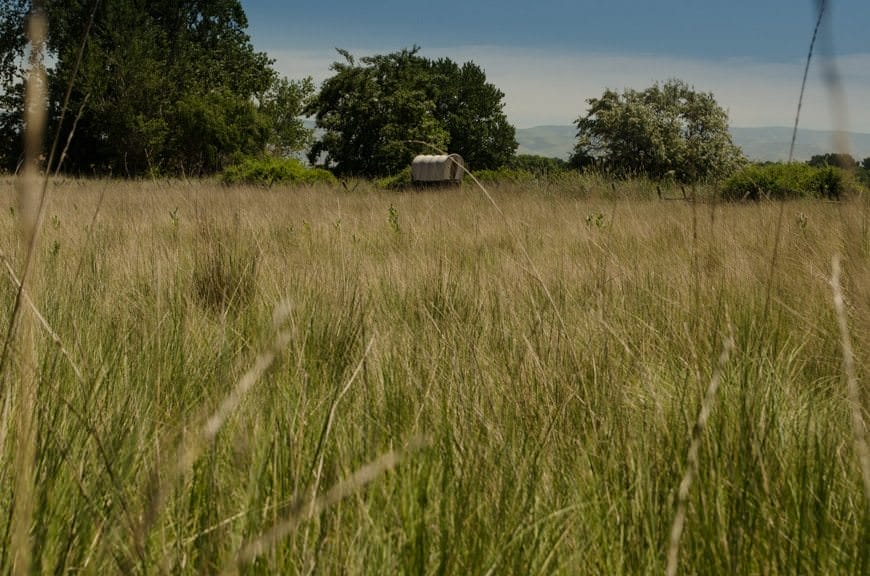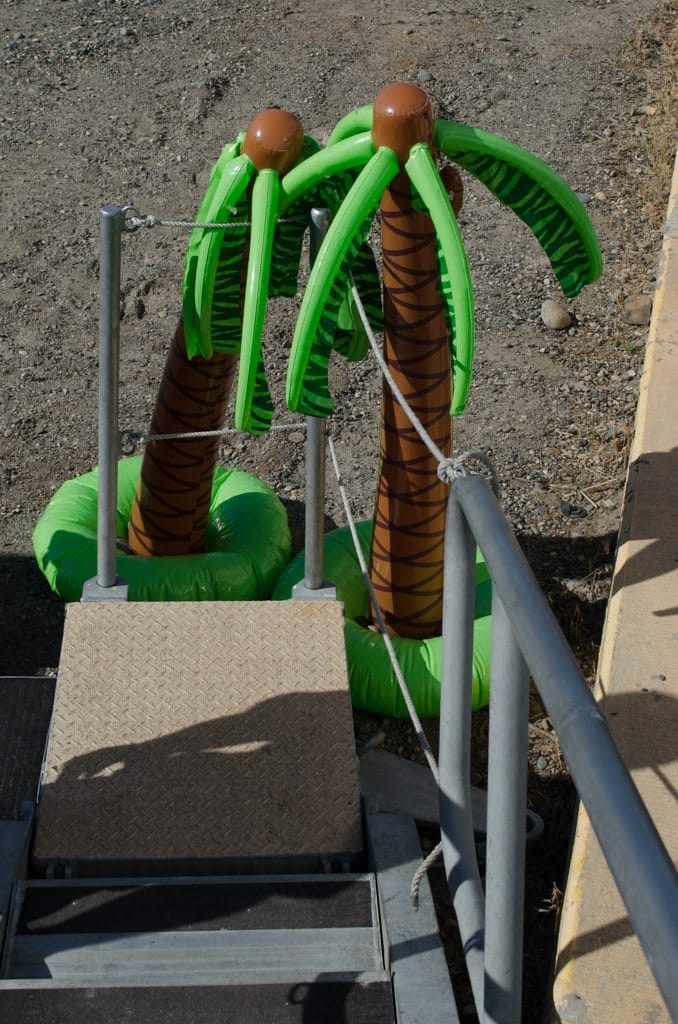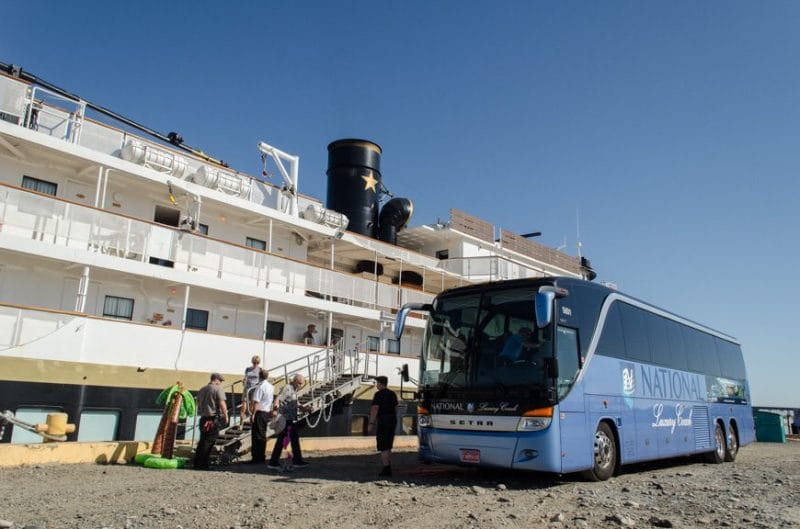Walla Walla: The Place So Nice They Named It Twice

Aaron Saunders, Live Voyage Reports
Wednesday, June 10, 2015
After days of being greeted by picturesque scenes the second I open the door to my stateroom each morning here onboard Un-Cruise Adventures’ S.S. Legacy, today came as something of a surprise. I opened my stateroom door just before 7:30 a.m., as I always do. But blue waters and lush forests didn’t stare back at me. Instead, a gravel port wasteland known as Burbank greeted my eyes.
It’s something straight out of a post-apocalyptic movie, with industrial siloes to the left, and a giant scrap metal processing plant to the right. The only thing missing is Arnold Schwarzenegger shouting, “Get in ze chopper!”
But it’s the best docking location for guests aboard the S.S. Legacy to reach our day of touring in Walla Walla, Washington; a more picturesque dock up river would add 45 minutes to the coach ride. So, each Wednesday, S.S. Legacy is a beacon of hope on this vast, Waterworld-esque landscape.

Mindful of appearances, Un-Cruise has humorously tried to dress up the gravel pier to resemble the more famous Burbank in California: two inflatable palm trees were stationed at the end of the gangway, along with a single bright pink plastic flamingo positioned between the gangway and our waiting motorcoach.

And who is out in this barren gravel wasteland known as Burbank? Why, it’s S.S. Legacy’s own charismatic Engineer, Jack! Days after delighting guests with his unique and engaging story about his “precious, precious microbes” that live deep in the bow of the ship and allow the toilets to function – so long as no foreign objects disturb them – Engineer Jack, clad in his black work overalls, proudly holds up some of his scrap metal finds as our powder blue coach zips past him.
So kudos to Un-Cruise for really putting the best spin on a docking location that is practical but hideously ugly and getting guests’ days off on the right note.
Our first stop of the day was the Fort Walla Walla Museum. Hidden away in the southwest corner of the town, it is situated on the site of a 19th century military fort. Today, it features several exhibits and displays of traditional agricultural equipment that would have been used from pioneer times up until roughly the Second World War, along with a small pioneer settlement village and a military cemetery.
At first, the museum suffers from that same kind of malaise that afflicts so many educational institutions: drab exhibits with labels printed on a laser printer and haphazardly laminated in place. Fading photographs pinned on cardboard dividers. Full-scale plastic horses that all have “Do Not Touch!” signs plastered on them, as if touching the plastic horse will somehow cause it to run away. I wonder how much they cost to make…




But a stroll down to the pioneer village changed my mind entirely. Here, local interpreters in period costumes have assembled to bring the past to life and tell you about the buildings you happen to be in, and what you’re seeing around you.
One particular historic interpreter stood out: the gentleman at the Blacksmith Shop, who by the time I ambled up had developed quite a crowd around him. I could have listened to this guy talk all day as he explained to us how horseshoes were made (and how you could tell, just by glance, whether the shoes were made in the summer or the winter months), along with numerous other tools from the turn of the century.

Grasping a pair of gigantic pliers, he happily described how the device could be used to pull out an infected toe nail (“this’ll pop it right out!”), or perform minor surgery, if needed. For some turn-of-the-century doctors, the town blacksmith was as important as the chemist who mixed the ingredients in early medicines.
The verdict on the museum: a lot of fun, and a great illustration of early pioneer life. Inside the main interpretive center, the special exhibits on World War I and World War II in Walla Walla was particularly well-done, and very poignant.
We then made our way to our next stop, and always a favorite of any river cruise: lunch and wine tasting!
In this case, our wine tasting hosts would be Dunham Cellars, which boasts a winery and tasting room at a building next to the Walla Walla Regional Airport, of all places. But don’t let the location fool you: their wines are fantastic, and their tasting room is beautifully and cleverly decorated. And, you could do it all before hopping an Alaska Airlines flight to Seattle.
Today, winemaking is a huge part of Washington State – but it hasn’t always been that way. In fact, the Walla Walla Valley wasn’t officially recognized as an American Viticultural Valley until 1984, when four local wineries joined forces to help make the region what it is today. Thirty-one years later, and there are now over 100 wineries in the Walla Walla Valley.
Dunham Cellars is, this year, celebrating their 20th year in business. Founded in 1995, they offer eight different kinds of red wine, and four different white wine offerings.
Out of the ones I tried, my absolute favorite was their 2012 Trutina – a unique blend of Cabernet Sauvignon, Merlot, Malbec, Syrah, and Petit Verdot. But a close second was their 2012 Syrah, which had beautiful dark chocolate and cherry notes.

On the white side, their 2013 Lewis Vineyard Riesling was pleasantly surprising. If you’ve avoided Rieslings because of their tendency to favour the sweet, this one leans towards a sharper, crisper taste while still retaining a hint – just a hint – of that typical sweet, almost dessert wine-like quality that characterises most Rieslings.
All wined up, we made our way to the last stop of the day: the Whitman Mission. And I’m not entirely sure how I should feel about it.

In 1836, Dr. Marcus Whitman and his wife, Narcissa Prentiss Whitman, traveled west along the Oregon Trail to bring the message of the Bible to the local Indians who, according to one 1833 publication, were “seeking teachers of the Book of Heaven” – the Bible. The article was almost entirely fiction, but nevertheless, the Whitmans travelled west, eventually staking out a plot of land near present-day Walla Walla to “save” the local Indians.
This wasn’t just limited to preaching religious values. Realizing that the local Indians travelled with their very seasonal food sources and thus never stayed in the same spot for the entire year, Whitman tried to put a stop to it. He encouraged them to remain on their farms – under, of course, his direct care – year-round. It didn’t really take.
Though the native Cayuse people had varying degrees of interest in the religious worship, books and educational systems that the Whitmans had brought with them, it was for the most part a cordial if sometimes strained relationship. But the Whitman Mission’s prominent position as a refuge for travellers taking the Oregon Trail meant that disease and tension frequently graced the Whitman and Cayuse camps. A Measles epidemic in 1847 nearly wiped out the Cayuse, and the fact that Whitman’s medicine seemed to help the white travellers but not the Cayuse themselves sewed the seeds of doubt.
On November 29, 1847, a group of Cayuse attacked the mission and killed Whitman and his wife, along with seven children that had been orphaned along the Oregon Trail. Fifty others were taken captive by the Cayuse. It put a stop to organized missions in the Pacific Northwest, and led to an all-out war against the Cayuse led by “a volunteer militia.”
The site of this battle took place right in the Mission, where we stood this afternoon. Nothing remains of the mission itself, save for an Obelisk positioned high atop a hill overlooking the site that was commemorated 50 years after the massacre.

Here’s why I have an issue with this site: it still, to this day, largely portrays the Whitmans as the “saviours” of the Cayuse people (as if, after hundreds of years of successful existence, they somehow needed to be “saved”), and the Cayuse as murdering savages who killed women and children with reckless abandon. The site glosses over the fact that the missionaries settled on their lands, tried to alter their religious freedoms and ways of life, told them where to live, how to live, how to dress, and even how to speak.
Did the Whitmans deserve to die? Of course not. Misguided or not, they were doing what they felt was right at the time. The groundwork for the massacre was built upon a foundation of mistrust and misunderstandings that had simmered for the 11 years the Mission existed.
So! While I may not have agreed with everything the site had presented, I am glad to have visited it, as it remains an important piece of history within Washington State and the Pacific Northwest.
I’ll admit to having napped on the coach ride back to the S.S. Legacy. I must be getting old; I never used to nap, and now I seem to need it more and more. Personally, I blame this constant, near-100°F heat that we’ve been enjoying all week. I’m just not used to the Pacific Northwest being this hot!
What can I say about evenings aboard the S.S. Legacy that hasn’t already been said? Tonight progressed much as every other evening has: Happy Hour in the Lounge kicked off at 5:30p.m., with a special Bead Making class with Historical Guide Becky.
Cocktails of course followed this – as they usually do. Cindal, one of the bar stewards, made me what I think is the best cocktail I’ve ever had. She recommended putting spiced rum with Sprite. I said that sounded great, and she went off to make it, coming back a few moments later with a big smile on her face as she presented the drink. I like that – she really went above and beyond to create something original and interesting for me when I couldn’t decide what to order. Most people would just suggest something from the menu; she personalized it based on what she already knew I liked. Thoughtfulness is worth its weight in gold.
With one spiced-rum-and-sprite polished off, dinner took on its usual tone, following what I like to call the “Three F’s”: fun, frivolity and food.


This transitioned into another special presentation in the Lounge starting at 8:00p.m. sharp, where legendary Pacific Northwest figure Sam Hill (who looks suspiciously like our own Historical Guide Kenne) made an appearance to tell us of his history. We are, after all, going to see his home-turned-art-gallery tomorrow. I learned a lot from Kenne…er, Sam’s…talk. For example, did you know Sam Hill also built the fabulous white arch that graces the Peace Arch border crossing between British Columbia and Washington State where I-5 turns into BC Highway 99? Despite having personally driven across that border dozens of times, I didn’t – but I do now!
Tomorrow, we get to explore The Dalles, Oregon. It’s hard to believe we’re entering our second-last day of the trip so soon. In fact, if there’s one complaint I have about my voyage aboard the S.S. Legacy so far, it’s this: it’s going to be over too darn soon!
S.S. Legacy - Columbia & Snake Rivers
| DAY | PORT |
|---|---|
| Day 1 | Portland, Oregon |
| Day 2 | The Columbia River Gorge, Bonnyville Dam, Multnomah Falls |
| Day 3 | Cruising the Snake River |
| Day 4 | Clarkston & Hell's Canyon |
| Day 5 | Walla Walla, Washington |
| Day 6 | The Dalles, Oregon |
| Day 7 | Astoria, Oregon |
Our Live Voyage Report aboard Un-Cruise Adventures’ S.S. Legacy continues tomorrow as we explore The Dalles, Oregon! Be sure to follow along on twitter by following @deckchairblog or the hashtag #LiveVoyageReport.
















